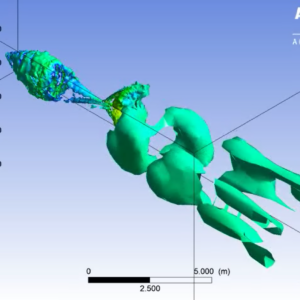When I entered my sophomore year in the fall of 2019, I was determined to get more hands-on engineering experience. I applied for a High Meadows Environmental Institute Internship to do research on a robotic tuna at the Princeton Gas Dynamics and Fluid Dynamics Lab. I was fortunate enough to have been accepted to the internship, and I spent the early part of 2020 getting ready to work under the tutelage of Professor Alexander Smits and postdoctoral scholar Dr. Liuyang Ding. The project was to conduct an experiment where we would measure the generated thrust force, power, and efficiency of a robotic tuna.
However, when the pandemic struck in March 2020, undergraduate students were not allowed to stay and work in the labs over the summer, so the project had to shift scope to become virtual. Instead of the original plan, my fellow MAE classmate Hayden Burt and I spent the summer (1) familiarizing ourselves with CAD and replicating the robot tuna tail fin designs, (2) learning computational fluid dynamics (CFD), and 3) replicating the water channel experimental set-up in ANSYS Fluent, a fluid simulation software. Personally, this shift in plans was bittersweet; I was excited to get my hands dirty working with the robotic tuna in the lab, but I also enjoyed adding CFD to my personal toolbox of programming and simulation tools.
As the set timeframe of the internship wrapped up, Hayden and I managed to recreate the experimental set-up but did not have the time to run further experiments with the simulation. As I had free time during my leave of absence, I decided to continue working on the robot tuna simulation with Liuyang through the fall of 2020 and spring of 2021. We plodded along slowly, but ultimately, we started to encounter technical problems with the simulation, the biggest issue being that the software did not have the level of accuracy and detail that we needed for a reliable experiment. Liuyang and I discussed this, and he determined that it would be best for the project to move away from simulations. I was a bit disappointed at first, but I understood the reasoning behind this decision and considered it a learning experience as I was still able to gain a good amount of experience with CAD and CFD.
When school resumed in-person in the fall of 2021, I finally saw the water channel experimental set-up in-person after one and a half years. Now, Liuyang and I are working with lasers and are using particle image velocimetry (PIV) to instantaneously visualize and measure the flow velocity in the water channel and correlate this to the propulsion methods of the robotic tuna.
I have two main takeaways from this experience. First is that the transition reminded me of the versatility, breadth, and value of computational science. This has even led me to pursue more research in computational science and attend PICSciE’s workshops and classes. Second is that I was reminded of the importance of flexibility and an open mind in research because anything can happen in a project, and the bright side is that research can be conducted from many different angles.
— Agnes Robang, Engineering Correspondent


